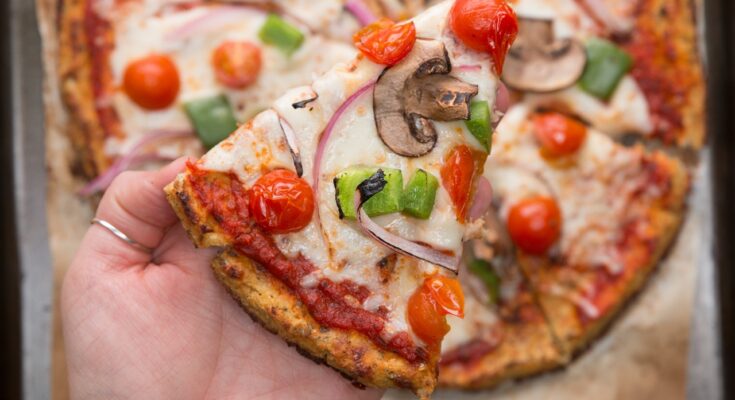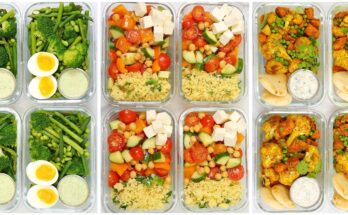Cauliflower Pizza Dough Recipe: Pizza is a universal comfort food. But let’s face it—the traditional flour-based crust can pack in unnecessary carbs and calories, especially if you’re trying to eat healthier. That’s where cauliflower pizza dough comes in. This low-carb alternative has quickly become a favorite for health-conscious eaters, keto enthusiasts, and anyone looking to enjoy pizza without guilt.
Cauliflower pizza dough is not only delicious but also surprisingly simple to make at home. With the right technique, you can create a crust that’s firm, flavorful, and ready to hold all your favorite toppings. Whether you’re new to the idea or already a fan of veggie-based crusts, this guide will take you step by step through the process.
Why Choose Cauliflower Pizza Dough?
The biggest reason people switch to cauliflower crust is health. It’s significantly lower in carbs compared to traditional pizza dough. Instead of feeling sluggish after indulging in a cheesy slice, you’ll feel light yet satisfied. Plus, it’s naturally gluten-free, making it a great option for those with gluten sensitivity.
Health Benefits of Cauliflower Crust
Cauliflower is loaded with vitamins C and K, fiber, and antioxidants. It supports digestion, boosts immunity, and can even help with weight management. When combined with eggs, cheese, and a few herbs, it turns into a nutrient-packed crust that rivals any wheat-based alternative.
Ingredients You’ll Need
To make the perfect cauliflower pizza dough, you don’t need fancy or hard-to-find ingredients. Most of these are already in your pantry or easily available at your local grocery store.
Essential Ingredients for the Dough
- 1 medium head of cauliflower (about 4 cups when grated)
- 1 large egg (acts as a binder)
- ½ to 1 cup shredded mozzarella cheese
- ¼ cup grated Parmesan cheese
- ½ teaspoon dried oregano
- ½ teaspoon garlic powder
- ½ teaspoon salt
- ¼ teaspoon black pepper
Optional Ingredients for Extra Flavor
Want to enhance the taste? Add these:
- Fresh basil or parsley (chopped)
- A pinch of chili flakes for spice
- A drizzle of olive oil for richness
Tools and Equipment Required
- Food processor or grater (to rice the cauliflower)
- Microwave-safe bowl
- Cheesecloth or clean kitchen towel (to squeeze out excess water)
- Baking sheet or pizza stone
- Parchment paper
- Mixing bowl
- Oven
Having these ready before you start makes the cooking process smooth and hassle-free.
Step-by-Step Guide to Making Cauliflower Pizza Dough
Now that you have everything prepared, let’s walk through the steps to create your homemade cauliflower pizza crust.
Step 1 – Prepping the Cauliflower
The base of your pizza begins with cauliflower rice. Wash and dry the cauliflower, remove the leaves, and chop it into small florets. Place the florets in a food processor and pulse until it resembles rice grains. If you don’t have a processor, you can grate the cauliflower with a box grater. The goal is to get fine, rice-like pieces without large chunks.
Step 2 – Cooking and Drying the Cauliflower
Spread the riced cauliflower in a microwave-safe bowl and cook it for about 5–6 minutes, or until soft. Let it cool slightly before handling. This step helps release moisture, which is crucial for a firm crust. After cooking, transfer it into a cheesecloth or clean towel and squeeze out as much liquid as possible. The drier the cauliflower, the crispier your crust will be. Skipping this step is the number one mistake beginners make!
Step 3 – Mixing the Dough Ingredients
In a large mixing bowl, combine the cooked cauliflower rice with egg, mozzarella, Parmesan, and seasonings. Stir until everything is well incorporated. The mixture should feel sticky but moldable. If it seems too wet, add a little more cheese or squeeze out more water from the cauliflower.
Step 4 – Shaping the Pizza Base
Line a baking sheet or pizza stone with parchment paper. Place the cauliflower mixture in the center and press it out into a circle or rectangle, depending on your preference. Aim for a thickness of about ¼ inch. Too thick, and it will be soggy; too thin, and it may break apart.
Step 5 – Baking the Cauliflower Pizza Dough
Preheat your oven to 425°F (220°C). Bake the crust for 20–25 minutes until it turns golden brown and firm to the touch. Remove from the oven, flip it gently using another piece of parchment, and bake for another 5–10 minutes. This ensures both sides are crisp and ready for toppings.
Once baked, your crust is ready to be topped with sauce, cheese, and your favorite toppings before going back into the oven for the final bake.
Tips for Perfect Cauliflower Pizza Crust
Making cauliflower pizza dough is simple, but perfecting it takes a little practice. A few tweaks in your method can make the difference between a soggy crust and a crispy, restaurant-quality base.
Common Mistakes to Avoid
One of the most common mistakes is not removing enough water from the cauliflower. Even if it looks dry, it often hides excess moisture that seeps out while baking. Always squeeze the cauliflower thoroughly until almost no water drips out. Using a thin towel or cheesecloth is best for this.
Another mistake is rushing the baking process. Cauliflower crust needs time to cook through, or else it will fall apart when topped. Always prebake the crust before adding toppings. Skipping this step leads to a floppy base that can’t hold the weight of cheese and veggies.
Overloading with toppings is another problem. Cauliflower dough is lighter than regular dough, so piling on too much sauce, cheese, and toppings can make it soggy. Stick to a balanced topping layer for the best results.
How to Make It Crispy
For a crispier crust, bake it on a pizza stone instead of a baking sheet. The stone absorbs excess moisture and distributes heat evenly. Another trick is to brush the edges of the crust with a little olive oil before baking, which enhances the golden color and adds flavor.
You can also try broiling the crust for a couple of minutes after baking. This extra step crisps it up perfectly and gives it a nice crunch. Just be sure to keep an eye on it so it doesn’t burn.
Best Toppings for Cauliflower Pizza Dough
Your crust is the canvas, and toppings are the artwork. One of the best things about cauliflower pizza dough is that it pairs beautifully with almost any topping, from classic combinations to bold experiments.
Classic Toppings
If you love traditional flavors, stick to the classics:
- Margherita Style – Tomato sauce, mozzarella cheese, and fresh basil.
- Pepperoni – Always a crowd-pleaser with its spicy, savory kick.
- Vegetable Medley – Bell peppers, onions, mushrooms, and olives for a healthy twist.
- BBQ Chicken – Shredded chicken, BBQ sauce, and red onions for a smoky, tangy flavor.
Creative and Healthy Topping Ideas
For those who like to get adventurous, try these ideas:
- Mediterranean Style – Hummus spread, feta cheese, olives, and sun-dried tomatoes.
- Breakfast Pizza – Top with scrambled eggs, spinach, and turkey bacon.
- Vegan Delight – Use cashew cheese, roasted zucchini, and caramelized onions.
- Spicy Kick – Add jalapeños, spicy sausage, and a drizzle of hot sauce.
The key is balance—don’t overload your pizza with too many heavy toppings. Instead, choose a few that complement each other in flavor and texture.
Nutritional Value of Cauliflower Pizza Dough
One of the best things about cauliflower pizza dough is how much lighter it is compared to regular pizza dough. If you’re counting calories, carbs, or trying to eat more vegetables, this recipe is a win.
Calories and Macronutrients
On average, one serving of cauliflower pizza dough (without toppings) contains around:
- 120–150 calories
- 7–9g of protein
- 8–10g of fat
- 6–8g of carbs
- 2–3g of fiber
Of course, the exact numbers vary depending on how much cheese and egg you use. Still, it’s a fraction of what traditional pizza crust contains.
Comparison with Regular Pizza Dough
A typical slice of regular pizza dough has around 200–250 calories and 30–35 grams of carbs—most of which are refined carbs that spike your blood sugar. Cauliflower crust, on the other hand, keeps carbs in check while offering fiber, vitamins, and protein.
This makes it not only lighter on your waistline but also better for sustained energy without the post-pizza crash.
Gluten-Free and Keto-Friendly Pizza Alternative
One of the biggest appeals of cauliflower pizza dough is its ability to fit into specific diets without sacrificing taste.
Why It’s Great for Keto and Low-Carb Diets
Keto dieters love cauliflower crust because it slashes carbs while still giving that “pizza feel.” Since it’s made mostly of cauliflower, eggs, and cheese, it’s naturally high in protein and fat while staying low in carbs. You can enjoy pizza night without getting kicked out of ketosis.
Gluten-Free Benefits
For those with celiac disease or gluten sensitivity, cauliflower pizza dough is a safe alternative to wheat-based crusts. Unlike some gluten-free crusts that rely on starches and gums, this version uses whole food ingredients, making it more wholesome and natural.
It’s proof that you don’t have to give up pizza just because you’re avoiding gluten.
Storage and Reheating Tips
One of the great things about cauliflower pizza dough is that you can make it ahead of time. With a few smart storage tips, you’ll have a ready-to-go crust whenever the craving hits.
How to Store Unbaked Cauliflower Dough
If you’d like to prep the dough in advance, follow the steps up to shaping the crust, then stop before baking. Place the shaped crust on parchment paper, slide it onto a baking sheet, and freeze until firm. Once frozen, transfer it to a freezer-safe bag or container. This way, you can keep it in the freezer for up to 2 months.
When you’re ready to use it, just bake it straight from frozen—no need to thaw. Add a couple of extra minutes to the baking time, and you’ll have a fresh crust ready for toppings.
Reheating Leftover Pizza
Got leftover slices? The best way to reheat cauliflower pizza is in the oven or on a skillet. Using the microwave makes it soggy, which defeats the purpose of all that effort to get a crispy crust.
- Oven method: Preheat the oven to 375°F (190°C), place slices on a baking sheet, and heat for 8–10 minutes.
- Skillet method: Place a slice in a non-stick pan over medium heat, cover with a lid, and warm for 4–5 minutes. This helps maintain crispiness on the bottom while melting the cheese on top.
Proper reheating means you’ll enjoy the same texture and flavor as when it was freshly baked.
Variations of Cauliflower Pizza Dough
The beauty of cauliflower pizza dough is its flexibility. You can tweak the recipe to suit your diet, preferences, or flavor cravings without losing its core benefits.
Vegan Version
To make a vegan crust, skip the egg and cheese. Instead, use a flax egg (1 tablespoon ground flaxseed + 3 tablespoons water) as a binder. For the cheesy flavor, add nutritional yeast or a plant-based cheese alternative. The texture will be slightly different, but it still holds together nicely.
Cheese-Free Option
If you’re cutting back on dairy but still want to enjoy cauliflower pizza dough, you can leave out the cheese entirely. The trick is to use extra egg or a bit of almond flour to help with structure. Herbs and spices also become more important here, so don’t be shy with oregano, garlic, and Italian seasoning.
Both of these variations show that cauliflower crust isn’t one-size-fits-all—it can adapt to almost any lifestyle.
FAQs about Cauliflower Pizza Dough Recipe
Q1: Does cauliflower pizza dough taste like regular pizza crust?
Not exactly. It has a lighter, slightly nutty flavor from the cauliflower, but once topped with sauce, cheese, and toppings, it’s surprisingly close.
Q2: How do I keep cauliflower crust from falling apart?
The key is removing as much water as possible from the cauliflower and prebaking the crust before adding toppings. These two steps make it firm and stable.
Q3: Can I make cauliflower pizza dough without a food processor?
Yes! You can use a box grater to rice the cauliflower. It takes more time, but the result is the same.
Q4: Is cauliflower pizza dough keto-approved?
Absolutely. It’s naturally low in carbs and high in fat and protein, making it an excellent choice for keto eaters.
Q5: Can I freeze cooked cauliflower pizza crust?
Yes. Bake the crust fully, let it cool, and then freeze it in an airtight bag. Reheat it in the oven before adding toppings.
Conclusion
Cauliflower pizza dough is proof that eating healthy doesn’t mean giving up the foods you love. With just a handful of ingredients and a little patience, you can create a crust that’s light, crispy, and versatile enough to suit any taste. Whether you’re following keto, eating gluten-free, or just trying to cut carbs, this recipe is a game-changer.
So next time you’re craving pizza, skip the takeout and try making this homemade cauliflower crust. It’s healthier, customizable, and delicious enough to win over even the pickiest pizza lovers.



